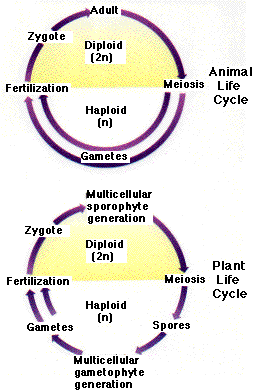Alternation of Generations
 Sexual reproduction involves the two alternating processes of meiosis and fertilization.
Sexual reproduction involves the two alternating processes of meiosis and fertilization.
- In meiosis, the chromosome number is reduced from the diploid to the haploid number.
- In fertilization, the nuclei of two gametes fuse, raising the chromosome number from haploid to diploid.
Whatever variation in details there may be from one organism to another, these two activities must occur alternately if sexual reproduction is to continue.
In animals, meiosis generates the haploid gametes - sperm and eggs - directly. These single cells fuse to form the zygote which will develop into another diploid animal.
In most plants meiosis and fertilization divide the life of the organism into two distinct phases or "generations".
- The gametophyte generation begins with a spore produced by meiosis. The spore is haploid, and all the cells derived from it (by mitosis) are also haploid. In due course, this multicellular structure produces gametes - by mitosis - and sexual reproduction then produces the diploid sporophyte generation.
- The sporophyte generation thus starts with a zygote. Its cells contain the diploid number of chromosomes. Eventually, though, certain cells will undergo meiosis, forming spores and starting a new gametophyte generation.
Two points revealed by plant life cycles:
- mitosis can occur in haploid cells as well as diploid ones.
- a haploid set of chromosomes, and hence a single set of genes (one genome), is sufficient to control cell function in these organisms (but not in most animals).
In fact, the gametophyte generation is the major stage in the life of mosses and an independent plant in ferns.
| Links to descriptions of the gametophytes of mosses and of ferns. |
However, the gametophyte is only an inconspicuous structure in angiosperms and other "higher" plants.
7 May 1999
 Sexual reproduction involves the two alternating processes of meiosis and fertilization.
Sexual reproduction involves the two alternating processes of meiosis and fertilization.